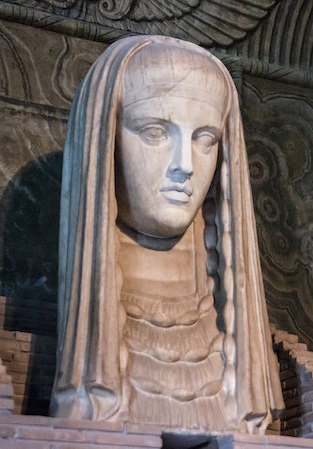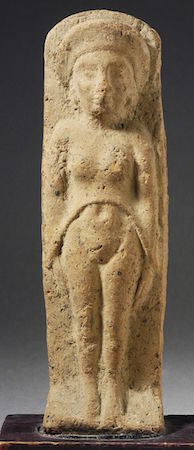Isis was closely associated with Hathor. In fact, the two goddesses are often so alike in appearance that only the hieroglyphic inscription can confirm which of them is actually portrayed (as in the depiction of the goddesses with Queen Nefertari). Both Hathor and Isis were linked to the star Spica (in the ancient constellation which was centered around the modern constellation of Virgo) because the star first appeared around harvest time.
A further link is provided by the fact that when Horus chopped off Isis’ head (because Isis would not strike the fatal blow against her brother Set) she responded by causing the head of a cow (one of the most common forms of Hathor) to grow in its place. She was also associated with Nut who also took the form of a cow and was associated with the sycamore tree.

Isis was also closely associated with her sister Nephthys and the two often bear a strong resemblance. Like Hathor it is often difficult to tell Nepythys from her sister Isis. The two sisters often appear together in funerary scenes and were frequently used to represent Upper and Lower Egypt (with Isis representing Upper Egypt).

It is sometimes suggested that Isis represented light and Nephthys represented the dark, but this is perhaps overstating the differences between them.
It would certainly be unfair to suggest that Nephthys was considered to be the evil or negative side of Isis. Rather the two goddesses were closely tied together and act together to protect the dead and the living.
When Amun was assimilated with Ra, his wife Mut merged with Ra’s wife, Isis-Hathor, as the composite deity Mut-Isis-Nekhbet. Mut was a mother goddess, like Isis, but was generally considered to be infertile and virginal. Thus, it was suggested that Isis became pregnant by magical means and was still a virgin. This is an interesting version of the idea of a virginal birth in which the power is firmly placed with the mother and not the (deceased) father. The situation was further complicated by the fact that Amun had become associated with Min and Amun-Min in turn was associated with both Ra and Horus, but was not so easily associated with Osiris (the deceased husband of Isis). As a result, Isis was sometimes described as the lover of Min, but was also occasionally described as his mother when Horus was described as her husband.
The goddess Serket was often seen as an aspect of Isis because of her power to cure scorpion stings and because of her role as one of the guardians who protected the four sons of Horus as they watched over the contents of the canopic jars. Furthermore, Serket was considered to be the patron of marriage and Isis was the epitome of a married woman.
She was linked with Seshat because of her wisdom and because Seshat had a son named “Hornub” (“golden Horus“). Due to her association with the life-giving waters of the Nile, she was closely associated with Anuket (also known as Ankhat or Anquat), Satis, and Hatmehyt . In her stellar aspect she was known as Khut (the light giver) at new year, and linked to Sopdet (or Sept) as the personification of Sirius – the star which rose shortly before the inundation. This link was strengthened by an association between Osiris and Sahu (the husband of Sopdet) and Horus and Sopdu.
As a goddess of agriculture she was known as Kekhet, as goddess of fields and cultivated lands, and Tcheft (or That), as goddess of the food offerings which were to be presented to the gods. As an earth goddess she was associated with Usert. She absorbed Thenenet (a goddess in the underworld) and as a goddess of the dead she was associated with Amentet (because she gave the deceased bread and the breath of life) and Ma’at (as she was sometimes described as one who judged the souls of the dead).
Isis merged with Renenutet as Isermithis or Thermounthis in her role as mother and was associated with Heqet and Tawaret (goddesses of childbirth). In leonine form she was associated with Aat, Menhet, Renpet, Weret-hekau (Urthekau), Heqet and Wadjet.
She also absorbed other local goddesses such as Hert (in Letopolis), Hetet (in Behutet), Hurt (in Nekhen), Thenenet (in Hermonthis), Ant (in Dendera), Mersekhen (in Herakleopolis), Neb-tept (in Arsinoe).

During the Late period she was often associated with a number of other goddesses throughout the ancient world, in particular Astarte. The Greeks associated her with Demeter, while the Romans associated her with Ceres but also worshipped her in her own right. Shrines were dedicated to her in Pompeii and Delos and even the Emperor Gaius himself dressed in female clothing and joined the mystery celebrations.



Her Latin epithet was “Stella Maris” (“Star of the Sea”) but she was also known as “Regina Coeli” (“queen of heaven”). However, her cult was considered by some to be a destructive influence on civilised society. The Emperor Augustus described the rituals as ‘pornographic’ and tried to promote Roman gods in her place.
Her cult eventually died out with the spread of Christianity in the sixth century AD although many have argued that her worship survived in the Christian devotion to the “Virgin Mary”. Thus, although her last temple closed in 550AD, worship of Isis never stopped, it merely changed form.
There is certainly more than a passing resemblance between images of the two, and both were (according to myth) virgins when they conceived their holy offspring. However, unlike Mary, Isis was powerful and independent and not just regarded as the mother of a god.

- Main page; Isis
- Isis, Osiris and Horus
- Isis and the Seven Scorpions
- Isis and Ra
- Temple of Isis, Philae
Copyright J Hill 2010